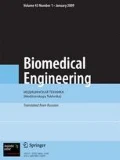A programmable system (PS) for robot-assisted mechanotherapy was developed for the rehabilitation of patients with diseases and traumas to the hip and knee joints. The medical device developed here differs from analogs in providing programming for remote control over the individual rehabilitation process in remote access conditions. Telemetric data recorded during rehabilitation training are stored in a remote information base for subsequent automated analysis, which provides for assessment of the effectiveness of the rehabilitation process and introduction of corrections to the rehabilitation program initially formulated for each patient. The interface of the information system is intuitive and does not require the user to have experience in working with personal computers.
Similar content being viewed by others
References
Zakhar’yan, A. G., “Characteristics of primary disability in the population of the Novosibirsk district,” in: Medicine and Education in Siberia: an Online Scientific Publication [in Russian], No. 1 (2015); http://ngmu.ru/cozo/mos/article/text_full.php?id=1662.
Chikinova, L. N. and Boltenko, Zh. V., “State and dynamics of primary disability due to musculoskeletal system and connective tissue diseases in the Central Federal District,” Med.-Sots. Ekspert. Reabil., No. 4. 30-33 (2014).
Salter, R. B., “The biological concept of continuous passive motion of synovial joint. The first eighteen years of basic research and its clinical implications,” Clin. Orthop., 242, 12-24 (1989).
Lomtatidze, E. Sh., Markin, V. A., Saraev, A. V., et al., “Use of CPM therapy in patients after trauma and orthopedic surgery in out-patient practice,” Vestn. Poslediplom. Med. Obraz., No. 2, 31-33 (2012).
Ryabchikov, I. V., Pankov, I. O., and Ryabchikova, E. N., “Passive mechanotherapy in the treatment of patients with combined trauma during the recovery period,” Byull. VSNTs SO RAMN, Supplement No. 4, 94 (2001).
Levinger, G. M., Lythgo, N., Cimoli, C., et al., “Targeted home and center-based exercise program for people after total hip replacement: A randomized clinical trial,” Arch. Phys. Med. Rehabil., 89, 442-1447 (2008).
Unlu, E., Eksioglu, E., Aydog, E. G., et al., “The effect of exercise on hip muscle strength, gait speed and cadence in patients with total hip arthroplasty: A randomized controlled study,” Clin. Rehabil., 21, 706-711 (2007).
Pimanchev, O. V., Brizhan’, L. K., Buryachenko, B. P., et al., “Prolonged CPM therapy in the rehabilitation of patients after total endoprosthetization of the knee joint,” Voenno-Med. Zh., No. 8, 52-53 (2013).
Chang, N. J., Lin, C. C., Li, C. F., et al., “The combined effects of continuous passive motion treatment and acellular PLGA implants on osteochondral regeneration in the rabbit,” Biomaterials, 33, No. 11, 3153-3163 (2012); http://research.ncku.edu.tw/re/commentary/e/20121228/1.html.
Steadman, R. J., Briggs, K. K., Rodrigo, J. J., et al., “Outcomes of microfracture for traumatic chondral defects of the knee: Average 11-year follow-up,” Arthroscopy, 19, No. 5, 477-484 (2003).
Chernikova, O. M., Sidorova, G. V., Arsent’eva, N. I., et al., “Potential for improvements in the rehabilitation of patients with the sequelae of trauma and musculoskeletal diseases at the regional level,” Med.-Sots. Ekspert. Reabil., No. 3, 6-8 (2012).
Peiris, C. L., Taylor, N. F., and Shields, N., “Patients receiving inpatient rehabilitation for lower limb orthopedic conditions do much less physical activity than recommended in guidelines for healthy older adults: An observational study,” J. Physiother., 59, No, 1, 39-44 (2013).
Filonenko, B. F., Filonenko, A. B., Shelyakina, O. V., and Mamonova, N. V., “An apparatus rehabilitation of the knee and hip joints,” Russian Federation P.m. 148127, MPK A61N 1/02(01); Applicant and Patentholder OOO Innovatory Rehabilitation Technologies, Filonenko, B. F., No. 2014132258/14, applied August 5, 2014; published November 27, 1014, Byul. No. 33 (2006).
Roos, E., Effectiveness and practice variation of rehabilitation after joint replacement,” Curr. Opin. Rheumatol., 15, 160-162 (2003).
Author information
Authors and Affiliations
Corresponding author
Additional information
Translated from Meditsinskaya Tekhnika, Vol. 51, No. 6, Nov.-Dec., 2017, pp. 36-39.
Rights and permissions
About this article
Cite this article
Shelyakina, O.V., Mamonova, N.V., Aronov, A.M. et al. A Robot-Assisted Mechanotherapy System for Remote Rehabilitation of Patients with Pathology of the Large Joints. Biomed Eng 51, 427–431 (2018). https://doi.org/10.1007/s10527-018-9763-6
Received:
Published:
Issue Date:
DOI: https://doi.org/10.1007/s10527-018-9763-6




